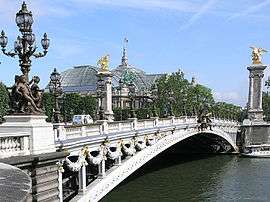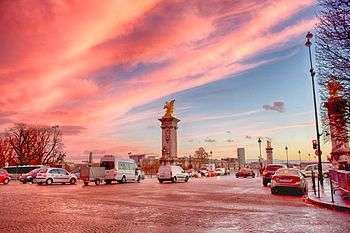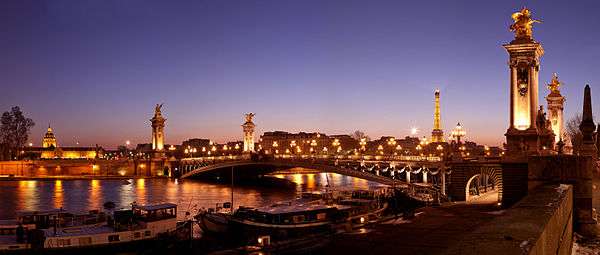Pont Alexandre III
| Pont Alexandre III | |
|---|---|
 Pont Alexandre III; Grand Palais in the background | |
| Crosses | The Seine River |
| Locale | Paris, France |
| Next upstream | Pont de la Concorde |
| Next downstream | Pont des Invalides |
| Characteristics | |
| Total length | 160 metres (520 ft)[1] |
| Width | 40 metres (130 ft)[1] |

The Pont Alexandre III is a deck arch bridge that spans the Seine in Paris. It connects the Champs-Élysées quarter with those of the Invalides and Eiffel Tower. The bridge is widely regarded as the most ornate, extravagant bridge in the city.[2][3] It is classified as a French Monument historique.

History
The Beaux-Arts style bridge, with its exuberant Art Nouveau lamps, cherubs, nymphs and winged horses at either end, was built between 1896 and 1900. It is named after Tsar Alexander III, who had concluded the Franco-Russian Alliance in 1892. His son Nicholas II laid the foundation stone in October 1896. The style of the bridge reflects that of the Grand Palais, to which it leads on the right bank.
The construction of the bridge is a marvel of 19th century engineering, consisting of a 6 metres (20 ft) high single span steel arch. The design, by the architects Joseph Cassien-Bernard and Gaston Cousin, was subject to strict controls that prevented the bridge from obscuring the view of the Champs-Élysées or the Invalides.
The bridge was built by the engineers Jean Résal and Amédée d'Alby. It was inaugurated in 1900 for the Exposition Universelle (universal exhibition) World's Fair, as were the nearby Grand Palais and Petit Palais.
Sculptures
Numerous sculptors provided the sculptures that feature prominently on the bridge.
"Fames"
Four gilt-bronze statues of Fames watch over the bridge, supported on massive 17 metres (56 ft) masonry socles, that provide stabilizing counterweight for the arch, without interfering with monumental views. The socles are crowned by Fames restraining Pegasus.
- On the Right Bank, Renommée des Sciences ("Fame of the Sciences") and the Renommée des Arts ("Fame of the Arts") both by Emmanuel Frémiet; at their bases, La France Contemporaine ("Contemporary France") by Gustave Michel and France de Charlemagne ("France of Charlemagne") by Alfred Lenoir. The lions groups are by Georges Gardet.
- On the Left Bank, the Renommée du Commerce ("Fame of Commerce") by Pierre Granet and the Renommée de l'Industrie ("Fame of Industry") by Clément Steiner; at their bases France de la Renaissance ("France of the Renaissance") by Jules Coutan and La France de Louis XIV ("France of Louis XIV") by Laurent Marqueste. The lions groups are by Jules Dalou.
"Nymphs"
The Nymph reliefs are at the centres of the arches over the Seine, memorials to the Franco-Russian Alliance. The "Nymphs of the Seine" has a relief of the arms of France, and faces the "Nymphs of the Neva" with the arms of Imperial Russia. They are both are executed in hammered copper over forms by Georges Récipon.
In the same political spirit, the Trinity Bridge in Saint Petersburg was conceived as a memorial to the Franco-Russian Alliance. It was designed by Gustave Eiffel, and the first stone laid in August 1897 by French president Félix Faure.
Cultural associations
- Films and videos
- In the animated film Anastasia (1997), the bridge is damaged by Rasputin in an attempt to kill Anastasia, who in real life was the granddaughter of Alexander III of Russia.
- In the film Angel-A it is the Pont Alexandre III from which Angela and André jump into the Seine.
- In the film French Postcards, the final romantic scene takes place on the bridge.
- In the film Midnight in Paris, the bridge is depicted in multiple scenes, including the final one.
- In the film Ronin, the spy team meets some arms dealers under the bridge on the Right Bank.
- In the film A Very Long Engagement, Marion Cotillard's character kills the character played by François Levantal under the bridge.
- In the 1985 James Bond film A View to a Kill, Bond (Roger Moore) comes to a halt at the bridge in a hijacked Renault 11 taxi.
- Adele's music video for the song "Someone Like You" was shot on the bridge in 2011.
References
- 1 2 "Alexandre III Bridge". Structurae—International Database for Civil and Structural Engineering. Wilhelm Ernst & Sohn Verlag. Retrieved 4 October 2014.
- ↑ Books.google.com: "the most ornate"
- ↑ Books.google.com: "the most extravagant"

External links
- Alexandre III Bridge at Structurae
- Pont Alexandre III
- Alexandre III Bridge, current photographs and of the 1900s.
| Wikimedia Commons has media related to Pont Alexandre-III. |
Coordinates: 48°51′49″N 2°18′49″E / 48.86361°N 2.31361°E
